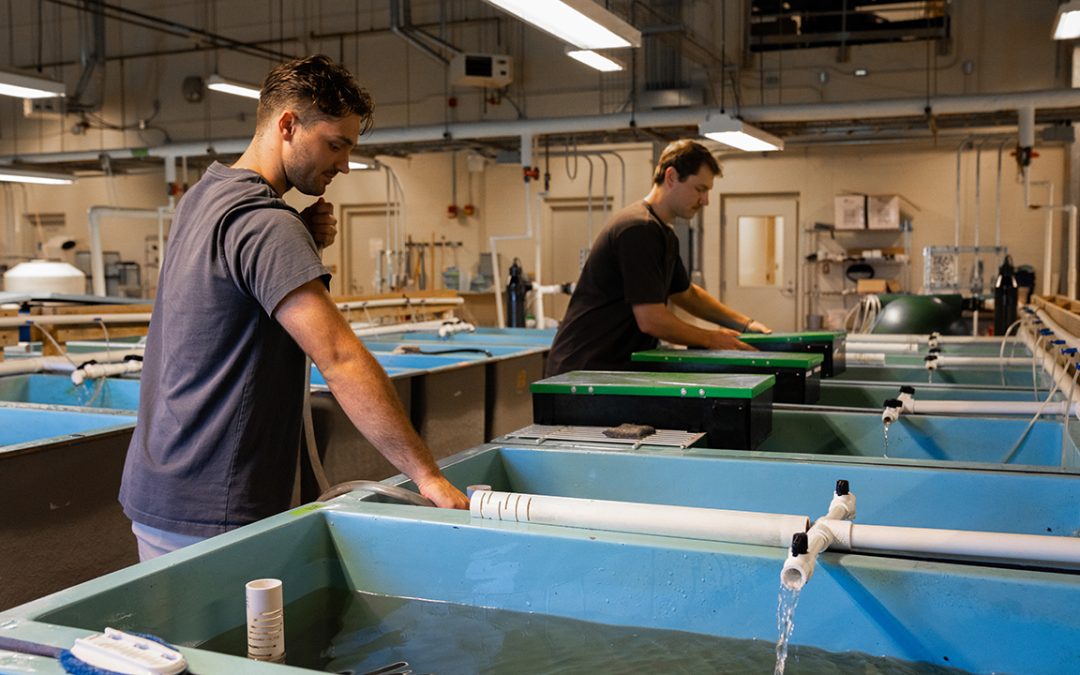The following story appears in the 2014 Auburn-LSU edition of Tailgate Times, an app-based publication of the Auburn University Food Systems Institute. Tailgate Times is published prior to each Auburn home football game. Download the app here and read more stories like this one every time the Auburn Tigers play at home.
by KAREN HUNLEY
When you sit down to enjoy a meal at a seafood restaurant, do you think about where your fish, crab, or other favorite dish came from? Many people love classic fried shrimp, for instance, but don’t realize that shrimp probably originated in another country. In fact, about 91 percent of all the seafood we eat is imported, says John Jensen, professor and interim director of the AU School of Fisheries, Aquaculture and Aquatic Sciences.
Is this a problem for the U.S. seafood industry? Absolutely. However, the industry is combating this and other challenges and remains critical to our economy—particularly in the Gulf of Mexico region, which includes Alabama, Mississippi, Louisiana, West Florida, and Texas.
In 2012, commercial fishermen in the Gulf region landed 1.7 billion pounds of finfish and shellfish, earning $763 million in landings revenue, according to the Fisheries Economics of the U.S. (2012) Gulf Region report. Landings revenue was dominated by shrimp ($392 million) and menhaden ($87 million). Although the shrimp is destined for human palates, menhaden is not considered fit for human consumption and is ground into fish meal and oil for use in pet foods, livestock and aquaculture feeds, and various industrial products.
In addition, crawfish, grouper, mullets, oysters, red snapper, stone crab, and tuna generated significant revenue. Here’s a glimpse at how Alabama and Louisiana fit into the picture.
Alabama seafood
The Heart of Dixie ranks fourth among the Gulf states in terms of seafood sales, with $461 million in sales in 2012. Although it is second-to-last in the Gulf region, there’s no doubt based on these sales that seafood—particularly shrimp—is a significant contributor to Alabama’s economy. Shrimp generated by far the most landings revenue of any other species with $39 million out of a total of $46 million in landings revenue. Oysters and mullet generated the second-most revenue, with just $1.2 million each.
Also, seafood accounted for about 9,947 jobs in Alabama in 2012, including commercial harvesters, processors and dealers, importers, wholesalers and distributors, and retail. There are currently 68 commercial fisheries in Alabama, as well as 103 wholesalers and processors, according to the 2012 Economic Census.
Louisiana seafood
For a true seafood lover, it doesn’t get much better than Louisiana’s wide variety of exotic, Cajun-inspired dishes. Crawfish etouffe, seafood jambalaya, shrimp gumbo—you’ll find seafood prepared in special ways everywhere you turn, so it’s no surprise the industry was responsible for $1.9 billion in sales in Louisiana in 2012.
As in Alabama, shrimp generated the most landings revenue for the state at $147 million out of $331 million total, followed by menhaden, which brought in about $65 million.
The seafood industry accounted for an impressive 33,391 jobs in Louisiana in 2012, and the state is home to 54 commercial establishments specializing in seafood products and preparation—the largest number in the Gulf region.
The challenge of imports
Now that you understand the numbers side of the regional seafood business, you might wonder if there are actual faces to help balance the raw data. The answer is “yes,” obviously.
Most of these faces can be found at commercial fisheries, seafood wholesalers, and processors, or among the slew of small mom-and-pop businesses on the Gulf Coast. There are countless family seafood operations in both states, and unfortunately, many struggle to compete with imports and keep their doors open.
And why are imports so much cheaper, driving down U.S. seafood costs? Because almost everything in competing countries such as Vietnam, China, and Brazil is cheaper—particularly labor and land costs, says Julie Anderson Lively, assistant professor, Louisiana State University (LSU) Ag Center and Louisiana Sea Grant.
“In most other countries, they can put in aquaculture (for growing seafood) right along the coastline. We can’t afford to do that here,” she says. In addition to higher land costs, the U.S. also has stricter environmental regulations governing aquaculture farming, for instance.
What can be done?
There’s little that can be done about the disparity between our land and labor costs and the costs in other countries, but the U.S. seafood industry can focus on producing and selling higher-quality shrimp. As Lively points out, there is a significant quality difference between imported frozen shrimp and fresh product.
“We can’t harvest enough to meet the demand in this country, but we can go after a niche market—people and retail establishments that actually care about quality and not just doing bulk popcorn shrimp where you probably can’t tell the difference,” she says.
Also, Lively says, the 2014 Farm Bill has recently implemented more rigorous inspections of imported catfish, with oversight moved from the FDA (which handles most imported seafood inspections) to the USDA. This may help domestic catfish producers, who have raised concerns that foreign catfish is raised using prohibited antibiotics and chemicals. Seafood importers are concerned, however, because now they will have to deal with two sets of inspectors.
In addition, the U.S. President has appointed a task force to study illegal, unreported, and unregulated fishing practices, as well as to crack down on mislabeling of seafood products, predominately different types of finfish. As much as a third of seafood sold in restaurants and groceries is fraudulently labeled, says a 2013 report from an advocacy group called Oceana.
Typically, a cheaper farmed fish like tilapia is substituted for wild-caught fish like red snapper. So it’s no surprise that oftentimes that “Gulf seafood” proudly touted on the menu at many beachside restaurants on the Gulf isn’t actually from the Gulf of Mexico, says Jensen.
“There have been a lot of problems either knowingly or unknowingly ending up with the wrong labels on fish, so the government has been trying to step up regulations and punishments,” Lively adds.
It is very difficult to determine where in the distribution chain the mislabeling occurs. More than half of the world’s fish production is processed at sea or shortly after landing, according to the law enforcement branch of the National Oceanic and Atmospheric Association (NOAA), so the species is usually unidentifiable without forensics such as expensive genetic testing.
For that reason, many Gulf fishermen and seafood retailers have started using the latest tracking technology to follow the fish along the supply chain, from the fishing boat to your plate. Fishermen enter detailed data on an electronic ticket, the catch is assigned a QR code, and additional information is added along the way to create a data stream of information that can be accessed by a consumer with a smartphone.
Other challenges
Alabama and Louisiana seafood operations also have had to cope with the aftermath of the disastrous 2010 oil spill as well as natural disasters like Hurricane Katrina. In Alabama, total landings revenue dropped to $26 million in 2010 after staying between $36 million and about $49 million the previous seven years (revenue was $38 million in 2009). Louisiana dropped from $296 million to $247 million from 2009 to 2010.
While the industry seems to be bouncing back from the oil spill, it hasn’t completely recovered, Lively says, especially Louisiana oysters. This is because oysters require a certain level of salinity (salt) to survive, and after the oil spill the state decided to open the freshwater diversions off the Mississippi River, which are sometimes used to combat flooding by diverting water into the ocean.
Authorities also opened them in 2011 because of historic flooding in the state. All this freshwater flowing into the oysters’ habitats two years in a row lowered the water salinity too much and killed off most oysters, Lively explains.
Since baby oysters require a particularly high level of salinity to survive and take a couple of years to reach market size, there’s still some uncertainty whether the Louisiana supply of this delicacy has totally recovered. But it appears to be improving, Lively says.
Natural disasters like Hurricane Katrina (2005) and Hurricane Isaac (2012) also pose a other threats to seafood operations on the Gulf Coast, sometimes literally washing away small businesses that can’t afford to start over. For those able to reopen after Katrina, the oil spill was another major setback that caused many to close their doors indefinitely.
“Anytime we have a hurricane, there is usually some sort of major impact to fisheries in the state, at least at a local level,” Lively says.
For more information, contact Jacque Kochak with the Auburn University Food Systems Institute at 334-844-7465.




